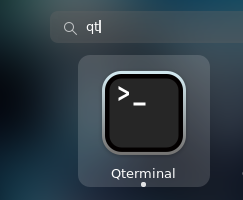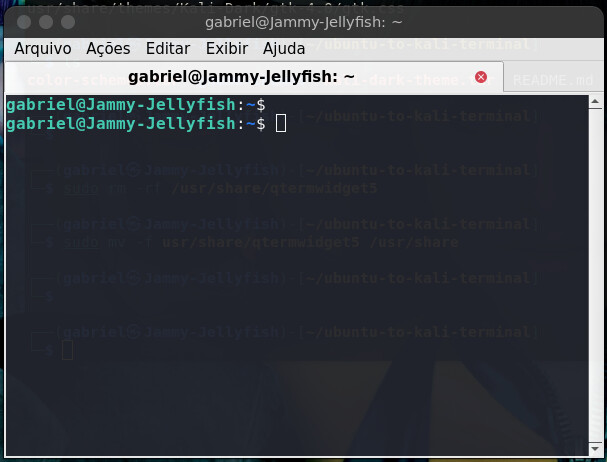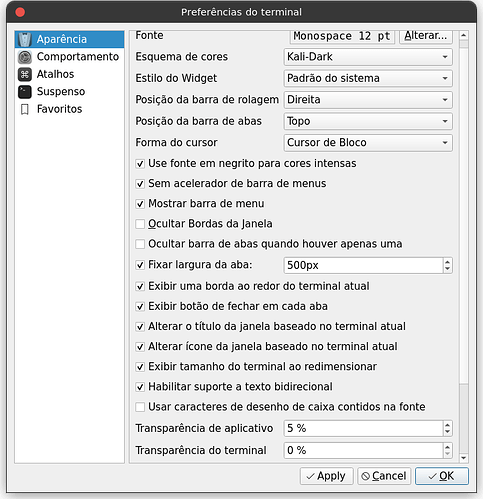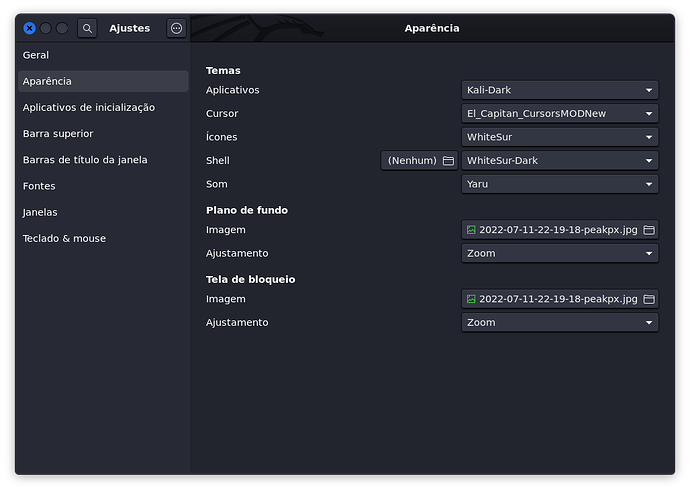Recentemente Instalei e o Kali Linux e pude perceber que o Shell do Kali é muito mais bonito e interativo, com seus highlights, autocomplete e sugestões de comando. Fui pesquisar em alguns fóruns o que eu poderia fazer para deixar o Terminal do Ubuntu com essa mesma aparência também.
Encontrei vários conteúdos referentes ao Z Shell (ZSH) então resolvi fazer um compilado do que funcionou pra mim e a maneira que achei de deixar o terminal o mais parecido com o Kali, esse “How To Make” serve para registro e documentação futura para quem tiver com o mesmo desejo.
1. Instalando Pacotes Necessários:
$ sudo apt update
$ sudo apt install zsh
O comando para instalação do ZSH irá permitir alguns recursos como:
- Autocomplete
- Corretor Ortográfico
- Suporte a Temas
- Histórico de Comandos
- Outros Recursos
Após a instalação do ZSH execute o comando abaixo selecione a opção 0 para alterar o prompt do bash para o Z Shell:
$ zsh
2. Instalando Plugins ZShell:
$ sudo apt install zsh-syntax-highlighting zsh-autosuggestions
O comando acima tem a função de instalar o:
- zsh-syntax-highlighting - permite o destaque da sintaxe digitada no Shell, permitindo revisão e detecção de erros de sintaxe antes de executar o comando;
- zsh-autosuggestions - sugere comando baseado em histórico.
3. Instalando Fontes, QTerminal e Gnome-Tweaks:
$ sudo apt install qterminal fonts-firacode gnome-tweaks
O comando acima tem a função de instalar o:
- QTerminal - Emulador de Terminal baseado no QTermWidget, por padrão o Ubuntu usa o terminal gnome;
- fonts-firacode - fonte monoespaçada;
- Gnome-Tweaks - Permite a personalização e aparencia de funcionalidades no Gnome.
4. Setar Shell Padrão:
Para setar o Shell padrão usamos o comando:
$ chsh -s /bin/zsh
Obs.: o Ubuntu usa /bin/bash
Saia do terminal e abra-o novamente, para verificar se a modificação foi feita com sucesso execute o comando abaixo e verifique se a saída corresponde a zsh
$ echo $0
Obs.: Nesse momento fazre o logout no computador e logar novamente.
5. Custumizar Ubuntu Terminal:
Agora com os plugins e ferramentas do ZSH instaladas vamos começar a customizar o Terminal:
5.1. Modificar Arquivo zshrc:
Arquivo de personalização e configuração do Z Shell, parecido com o bashrc no Shell Bash. Se trata de um arquivo de inicialização oculto, caso o arquivo já exista, podemos excluí-lo já que ele deverá ter seu conteúdo substituído:
$ rm ~/.zshrc
$ touch ~/.zshrc
Após criar o arquivo oculto, edita-lo com com o conteúdo abaixo do comando a seguir:
$ sudo nano ~/.zshrc
# ~/.zshrc file for zsh interactive shells.
# see /usr/share/doc/zsh/examples/zshrc for examples
setopt autocd # change directory just by typing its name
#setopt correct # auto correct mistakes
setopt interactivecomments # allow comments in interactive mode
setopt magicequalsubst # enable filename expansion for arguments of the form ‘anything=expression’
setopt nonomatch # hide error message if there is no match for the pattern
setopt notify # report the status of background jobs immediately
setopt numericglobsort # sort filenames numerically when it makes sense
setopt promptsubst # enable command substitution in prompt
WORDCHARS=${WORDCHARS//\/} # Don't consider certain characters part of the word
# hide EOL sign ('%')
PROMPT_EOL_MARK=""
# configure key keybindings
bindkey -e # emacs key bindings
bindkey ' ' magic-space # do history expansion on space
bindkey '^U' backward-kill-line # ctrl + U
bindkey '^[[3;5~' kill-word # ctrl + Supr
bindkey '^[[3~' delete-char # delete
bindkey '^[[1;5C' forward-word # ctrl + ->
bindkey '^[[1;5D' backward-word # ctrl + <-
bindkey '^[[5~' beginning-of-buffer-or-history # page up
bindkey '^[[6~' end-of-buffer-or-history # page down
bindkey '^[[H' beginning-of-line # home
bindkey '^[[F' end-of-line # end
bindkey '^[[Z' undo # shift + tab undo last action
# enable completion features
autoload -Uz compinit
compinit -d ~/.cache/zcompdump
zstyle ':completion:*:*:*:*:*' menu select
zstyle ':completion:*' auto-description 'specify: %d'
zstyle ':completion:*' completer _expand _complete
zstyle ':completion:*' format 'Completing %d'
zstyle ':completion:*' group-name ''
zstyle ':completion:*' list-colors ''
zstyle ':completion:*' list-prompt %SAt %p: Hit TAB for more, or the character to insert%s
zstyle ':completion:*' matcher-list 'm:{a-zA-Z}={A-Za-z}'
zstyle ':completion:*' rehash true
zstyle ':completion:*' select-prompt %SScrolling active: current selection at %p%s
zstyle ':completion:*' use-compctl false
zstyle ':completion:*' verbose true
zstyle ':completion:*:kill:*' command 'ps -u $USER -o pid,%cpu,tty,cputime,cmd'
# History configurations
HISTFILE=~/.zsh_history
HISTSIZE=1000
SAVEHIST=2000
setopt hist_expire_dups_first # delete duplicates first when HISTFILE size exceeds HISTSIZE
setopt hist_ignore_dups # ignore duplicated commands history list
setopt hist_ignore_space # ignore commands that start with space
setopt hist_verify # show command with history expansion to user before running it
#setopt share_history # share command history data
# force zsh to show the complete history
alias history="history 0"
# configure `time` format
TIMEFMT=$'\nreal\t%E\nuser\t%U\nsys\t%S\ncpu\t%P'
# make less more friendly for non-text input files, see lesspipe(1)
#[ -x /usr/bin/lesspipe ] && eval "$(SHELL=/bin/sh lesspipe)"
# set variable identifying the chroot you work in (used in the prompt below)
if [ -z "${debian_chroot:-}" ] && [ -r /etc/debian_chroot ]; then
debian_chroot=$(cat /etc/debian_chroot)
fi
# set a fancy prompt (non-color, unless we know we "want" color)
case "$TERM" in
xterm-color|*-256color) color_prompt=yes;;
esac
# uncomment for a colored prompt, if the terminal has the capability; turned
# off by default to not distract the user: the focus in a terminal window
# should be on the output of commands, not on the prompt
force_color_prompt=yes
if [ -n "$force_color_prompt" ]; then
if [ -x /usr/bin/tput ] && tput setaf 1 >&/dev/null; then
# We have color support; assume it's compliant with Ecma-48
# (ISO/IEC-6429). (Lack of such support is extremely rare, and such
# a case would tend to support setf rather than setaf.)
color_prompt=yes
else
color_prompt=
fi
fi
configure_prompt() {
prompt_symbol=㉿
# Skull emoji for root terminal
#[ "$EUID" -eq 0 ] && prompt_symbol=💀
case "$PROMPT_ALTERNATIVE" in
twoline)
PROMPT=$'%F{%(#.blue.green)}┌──${debian_chroot:+($debian_chroot)─}${VIRTUAL_ENV:+($(basename $VIRTUAL_ENV))─}(%B%F{%(#.red.blue)}%n'$prompt_symbol$'%m%b%F{%(#.blue.green)})-[%B%F{reset}%(6~.%-1~/…/%4~.%5~)%b%F{%(#.blue.green)}]\n└─%B%(#.%F{red}#.%F{blue}$)%b%F{reset} '
# Right-side prompt with exit codes and background processes
#RPROMPT=$'%(?.. %? %F{red}%B⨯%b%F{reset})%(1j. %j %F{yellow}%B⚙%b%F{reset}.)'
;;
oneline)
PROMPT=$'${debian_chroot:+($debian_chroot)}${VIRTUAL_ENV:+($(basename $VIRTUAL_ENV))}%B%F{%(#.red.blue)}%n@%m%b%F{reset}:%B%F{%(#.blue.green)}%~%b%F{reset}%(#.#.$) '
RPROMPT=
;;
backtrack)
PROMPT=$'${debian_chroot:+($debian_chroot)}${VIRTUAL_ENV:+($(basename $VIRTUAL_ENV))}%B%F{red}%n@%m%b%F{reset}:%B%F{blue}%~%b%F{reset}%(#.#.$) '
RPROMPT=
;;
esac
unset prompt_symbol
}
# The following block is surrounded by two delimiters.
# These delimiters must not be modified. Thanks.
# START KALI CONFIG VARIABLES
PROMPT_ALTERNATIVE=twoline
NEWLINE_BEFORE_PROMPT=yes
# STOP KALI CONFIG VARIABLES
if [ "$color_prompt" = yes ]; then
# override default virtualenv indicator in prompt
VIRTUAL_ENV_DISABLE_PROMPT=1
configure_prompt
# enable syntax-highlighting
if [ -f /usr/share/zsh-syntax-highlighting/zsh-syntax-highlighting.zsh ]; then
. /usr/share/zsh-syntax-highlighting/zsh-syntax-highlighting.zsh
ZSH_HIGHLIGHT_HIGHLIGHTERS=(main brackets pattern)
ZSH_HIGHLIGHT_STYLES[default]=none
ZSH_HIGHLIGHT_STYLES[unknown-token]=fg=white,underline
ZSH_HIGHLIGHT_STYLES[reserved-word]=fg=cyan,bold
ZSH_HIGHLIGHT_STYLES[suffix-alias]=fg=green,underline
ZSH_HIGHLIGHT_STYLES[global-alias]=fg=green,bold
ZSH_HIGHLIGHT_STYLES[precommand]=fg=green,underline
ZSH_HIGHLIGHT_STYLES[commandseparator]=fg=blue,bold
ZSH_HIGHLIGHT_STYLES[autodirectory]=fg=green,underline
ZSH_HIGHLIGHT_STYLES[path]=bold
ZSH_HIGHLIGHT_STYLES[path_pathseparator]=
ZSH_HIGHLIGHT_STYLES[path_prefix_pathseparator]=
ZSH_HIGHLIGHT_STYLES[globbing]=fg=blue,bold
ZSH_HIGHLIGHT_STYLES[history-expansion]=fg=blue,bold
ZSH_HIGHLIGHT_STYLES[command-substitution]=none
ZSH_HIGHLIGHT_STYLES[command-substitution-delimiter]=fg=magenta,bold
ZSH_HIGHLIGHT_STYLES[process-substitution]=none
ZSH_HIGHLIGHT_STYLES[process-substitution-delimiter]=fg=magenta,bold
ZSH_HIGHLIGHT_STYLES[single-hyphen-option]=fg=green
ZSH_HIGHLIGHT_STYLES[double-hyphen-option]=fg=green
ZSH_HIGHLIGHT_STYLES[back-quoted-argument]=none
ZSH_HIGHLIGHT_STYLES[back-quoted-argument-delimiter]=fg=blue,bold
ZSH_HIGHLIGHT_STYLES[single-quoted-argument]=fg=yellow
ZSH_HIGHLIGHT_STYLES[double-quoted-argument]=fg=yellow
ZSH_HIGHLIGHT_STYLES[dollar-quoted-argument]=fg=yellow
ZSH_HIGHLIGHT_STYLES[rc-quote]=fg=magenta
ZSH_HIGHLIGHT_STYLES[dollar-double-quoted-argument]=fg=magenta,bold
ZSH_HIGHLIGHT_STYLES[back-double-quoted-argument]=fg=magenta,bold
ZSH_HIGHLIGHT_STYLES[back-dollar-quoted-argument]=fg=magenta,bold
ZSH_HIGHLIGHT_STYLES[assign]=none
ZSH_HIGHLIGHT_STYLES[redirection]=fg=blue,bold
ZSH_HIGHLIGHT_STYLES[comment]=fg=black,bold
ZSH_HIGHLIGHT_STYLES[named-fd]=none
ZSH_HIGHLIGHT_STYLES[numeric-fd]=none
ZSH_HIGHLIGHT_STYLES[arg0]=fg=cyan
ZSH_HIGHLIGHT_STYLES[bracket-error]=fg=red,bold
ZSH_HIGHLIGHT_STYLES[bracket-level-1]=fg=blue,bold
ZSH_HIGHLIGHT_STYLES[bracket-level-2]=fg=green,bold
ZSH_HIGHLIGHT_STYLES[bracket-level-3]=fg=magenta,bold
ZSH_HIGHLIGHT_STYLES[bracket-level-4]=fg=yellow,bold
ZSH_HIGHLIGHT_STYLES[bracket-level-5]=fg=cyan,bold
ZSH_HIGHLIGHT_STYLES[cursor-matchingbracket]=standout
fi
else
PROMPT='${debian_chroot:+($debian_chroot)}%n@%m:%~%(#.#.$) '
fi
unset color_prompt force_color_prompt
toggle_oneline_prompt(){
if [ "$PROMPT_ALTERNATIVE" = oneline ]; then
PROMPT_ALTERNATIVE=twoline
else
PROMPT_ALTERNATIVE=oneline
fi
configure_prompt
zle reset-prompt
}
zle -N toggle_oneline_prompt
bindkey ^P toggle_oneline_prompt
# If this is an xterm set the title to user@host:dir
case "$TERM" in
xterm*|rxvt*|Eterm|aterm|kterm|gnome*|alacritty)
TERM_TITLE=$'\e]0;${debian_chroot:+($debian_chroot)}${VIRTUAL_ENV:+($(basename $VIRTUAL_ENV))}%n@%m: %~\a'
;;
*)
;;
esac
precmd() {
# Print the previously configured title
print -Pnr -- "$TERM_TITLE"
# Print a new line before the prompt, but only if it is not the first line
if [ "$NEWLINE_BEFORE_PROMPT" = yes ]; then
if [ -z "$_NEW_LINE_BEFORE_PROMPT" ]; then
_NEW_LINE_BEFORE_PROMPT=1
else
print ""
fi
fi
}
# enable color support of ls, less and man, and also add handy aliases
if [ -x /usr/bin/dircolors ]; then
test -r ~/.dircolors && eval "$(dircolors -b ~/.dircolors)" || eval "$(dircolors -b)"
export LS_COLORS="$LS_COLORS:ow=30;44:" # fix ls color for folders with 777 permissions
alias ls='ls --color=auto'
#alias dir='dir --color=auto'
#alias vdir='vdir --color=auto'
alias grep='grep --color=auto'
alias fgrep='fgrep --color=auto'
alias egrep='egrep --color=auto'
alias diff='diff --color=auto'
alias ip='ip --color=auto'
export LESS_TERMCAP_mb=$'\E[1;31m' # begin blink
export LESS_TERMCAP_md=$'\E[1;36m' # begin bold
export LESS_TERMCAP_me=$'\E[0m' # reset bold/blink
export LESS_TERMCAP_so=$'\E[01;33m' # begin reverse video
export LESS_TERMCAP_se=$'\E[0m' # reset reverse video
export LESS_TERMCAP_us=$'\E[1;32m' # begin underline
export LESS_TERMCAP_ue=$'\E[0m' # reset underline
# Take advantage of $LS_COLORS for completion as well
zstyle ':completion:*' list-colors "${(s.:.)LS_COLORS}"
zstyle ':completion:*:*:kill:*:processes' list-colors '=(#b) #([0-9]#)*=0=01;31'
fi
# some more ls aliases
alias ll='ls -l'
alias la='ls -A'
alias l='ls -CF'
# enable auto-suggestions based on the history
if [ -f /usr/share/zsh-autosuggestions/zsh-autosuggestions.zsh ]; then
. /usr/share/zsh-autosuggestions/zsh-autosuggestions.zsh
# change suggestion color
ZSH_AUTOSUGGEST_HIGHLIGHT_STYLE='fg=#999'
fi
# enable command-not-found if installed
if [ -f /etc/zsh_command_not_found ]; then
. /etc/zsh_command_not_found
fi
compinit
Para que as alterações surtam efeito execute o comando abaixo e feche e reabra o terminal novamente:
$ source .zshrc
O resultado é o seguinte:

5.2. Color Scheme e Themes:
Download e descompressão do arquivo de Tema e Esquema de cores do Kali Linux
Obs.: É importante ter o git instalado, para execução do comando a baixo !!
$ git clone https://github.com/linuxopsys/ubuntu-to-kali-terminal.git
$ cd ubuntu-to-kali-terminal/
$ tar -xvf color-schemes.tar
$ tar -xvf kali-dark-theme.tar
Após a extração será observado um diretório usr dentro de ubuntu-to-kali-terminal/
Vamos agora remover o atual diretório qtermwidget5/ e substituílo pelo presente dentro desse usr/:
$ sudo rm -rf /usr/share/qtermwidget5
$ sudo mv -f usr/share/qtermwidget5 /usr/share
6. Alterando Configurações no Terminal:
Abrir o QTerminal :

e em Arquivo > Preferências
- Selecionar o Esquema de Cores Kali-Dark;
- Em Transparência de Aplicativo: 5%;
- Em Transparência de Terminal: 0%
Esses são os padrões usado pelo Shell do Kali
Após aplicar e concluir as modificaçõs o QTerminal deve se parecer com a imagem abaixo:

Se o QTerminal nao agradar é possível continuar com o terminal do Gnome do Ubuntu.
6.2 Alterar Tema do Sistema:
Agora basta mover o diretório Kali-Dark/ no diretório ubuntu-to-kali-terminal/ para o diretório de temas do sistema:
$ sudo mv -f usr/share/themes/Kali-Dark /usr/share/themes
Para aplicar o tema rode abra o Gnome-Tweaks com o comando:
gnome-tweaks
Em Aparência > Aplicativos selecione Kali-Dark:
Bonus:
Ainda é possivel instalar temas específicos no terminal usando instalando o Gogh:




